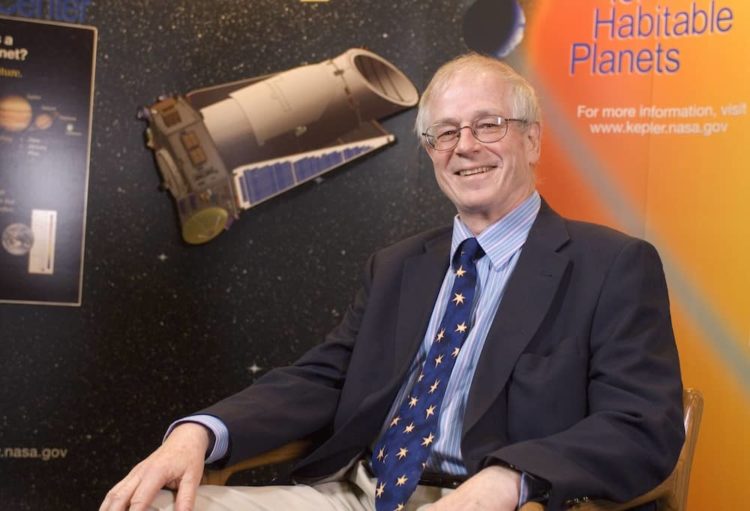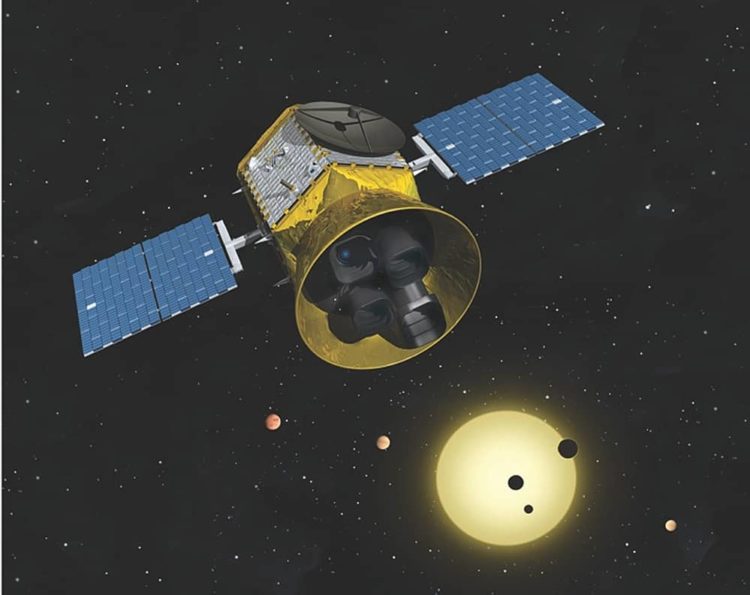
By Anne W. Semmes
One of the most intriguing questions of the human race is are we alone in the universe? Thanks to my astronomer stepbrother Michael Snowden, based in New Zealand, I’m learning of five leading efforts in the world to find that answer. The first shared earlier was the IceCube Neutrino Observatory built deep into the ice of Antarctica that is revealing “hidden features of our galaxy never before seen by humanity.” And introducing the second is the TESS project, NASA’s Transiting Exoplanet Survey Satellite (TESS) launched in 2018.
The TESS Satellite trains its cameras outside our solar system in the Milky Way Galaxy scanning for Earth-like planets orbiting nearby stars. The project’s Director of Science is David Latham, Michael’s longtime friend and astronomer at the Harvard-Smithsonian Center for Astrophysics. I had the recent pleasure of David’s company on a zoom in his office on a farm outside of Cambridge, not far from Harvard’s Smithsonian Astrophysical Observatory.
So, with the news of some 5,000-plus exoplanets (the exo for those outside our solar system) having been discovered, how does David view this TESS success? He corrects me to add exoplanet candidates meaning worthy of further investigation for signs of life. He also shares a higher figure of 6,500 exoplanets now discovered. Also impressively found David tells are “millions of stars,” believed at first to be in the hundreds of thousands.
Picture that TESS satellite transmitting its findings almost 24/7 with David and 650 astronomers around the world “contributing follow-up observations to confirm and characterize the planets” or show that they aren’t planets. “There’s a lot of false positives, stellar systems masquerading as planets.”
So, how in deep space do these exoplanets get spotted by those satellite cameras? “The most useful exoplanets are the ones that transit,” David tells. “And that’s because from the amount of light that they block, you can tell how big they are.” So, in their orbit passing across their star he explains, “It only takes a few hours, 2,3,4 hours typically for a planet to go from one apparent edge of the star to the other edge. And so, you see the light dim while it’s in front of the star, blocking some of the light. Just a tiny fraction, much less than one percent for something like the Earth…So, we have to make very precise measurements of the intensity of light coming from the stars, from millions of stars. And that’s what our instrument does.”
“So, it’s the only good way we have of getting the size of the planet,” he continues. But another “traditional” detection method is also used. “Radio velocities look for changes in the motion of the host star along the line of sight in response to the pull of the orbiting planet…When you combine that with the transit observations, you learn a lot more because from the radio velocity orbit, you can deduce the mass ratio,” and then, “you have the size of the planet relative to the star.” He adds, “It also lets us calculate the scale height of the atmosphere. And that’s really important when we go about trying to study the atmospheres of exoplanets.”
“We’re getting at the actual composition and temperature of the atmospheres,” he notes. “So, we can tell whether they are the right temperature, whether they have any evidence for water in their atmospheres, which we happen to think is important for habitability. And is the temperature right for the water to be liquid, like it is on the earth…We’re really interested in looking for planets that have surfaces, rocky planets like the Earth and Venus and Mars that have surfaces and have atmospheres that might be hospitable for the invention of life and then evolution of life.”
So, in the news lately was the TESS discovery of two of the “longest period exoplanets” found to date. Might he explain their importance? “Long period transiting planets are very rare because it means the separation between the planet and the star is large. So, the alignment has to be just exactly right in order for the planet to go in front of the star. So, the longest period that we’ve confirmed, I think is 480 days, but there’ll be longer periods. You just have to look up millions of stars in order to find those rare transiting planets that are exactly lined up, so we see them transit.”
And do these exoplanets each have a name? “They have a number, TOI [TESS object of interest], then four digits. That means it’s a candidate to be a transiting planet. Then we have to do a lot of follow-up observations to confirm that. And secondly, that it’s not an imposter, it’s actually a planet in orbit around the star. That’s the work that we do most of the time now.”
So, what’s a typical workday for David? “Well, I get up in the morning and I look to see how the observations went last night in the Whipple Observatory in Arizona. [Its telescopes and instrumentation courtesy of David’s handiwork]. And we have a spectroscopic instrument out there that is following up on all the TESS objects of interest as they get released, doing the initial reconnaissance spectroscopy. I review all those observations. I update the observation plans. And that typically takes three or four hours. And then I turn to my email where I review all the papers that people are getting ready to submit. Typically, I work 12 hours a day, sometimes only 10.”

So, with all this downloading of information from the recorder on the TESS spacecraft for public access, David has noted that other astronomers have come to realize that sitting right in front of their noses is data they can use to make major discoveries? “That’s the most important thing if you go by the number of papers,” he says. “General astrophysics, not looking for exoplanets but learning about stars, learning about supernova explosions, finding asteroids in the solar system. TESS is being used for that kind of astronomy, and we give them full frame images, we cover the whole sky, we bring everything down.” But he adds, notably, “But we sold the mission on the goal of finding habitable planets.”
There’s no question that the success of TESS has brought an extraordinary interest in exoplanets from astronomers. News from Michael was that come March 16 some 800 astronomers were traveling to Christchurch, New Zealand for a conference on exoplanets, with David likely to join them.
But a question has to be asked – if in our lifetime one of these exoplanets is shown to have all the necessary habitable ingredients or whatever, what good is it for us because it’s so far away?
“Oh, this is curiosity-driven science,” he responds. “We just got to know. Wouldn’t you like to know if there’s life elsewhere in the universe? Once we discover it, we can start sending messages in their direction. Or maybe we should be listening to see if they’re sending messages to us. Because if they’re far advanced to our civilization with their technical capabilities, then they will know that the solar system, the earth going around the sun, can view their system as a transiting system.”
“And so,” he continues, “we might realize that they would be a potential site for the development of a technical civilization. And they could be sending us messages. So, one of the things that the SETI [Search for Extraterrestrial Intelligence] community is doing is they’re looking for signals from the transiting planets that we find. But nobody has found anything, so far. That’s a long shot. But if we get a message and can decode it, that will be pretty dramatic!”
Is he of the same mind of his colleague and my stepbrother Michael that, “of course, we’re going to find life somewhere out there.” “Well, yes,” he agreed, “But is it going to be in our lifetime or not?”
Up next is Gaia, a European Space Agency astronomical observatory mission, launched in 2013, to create the largest, most precise three-dimensional map of the Milky Way.




